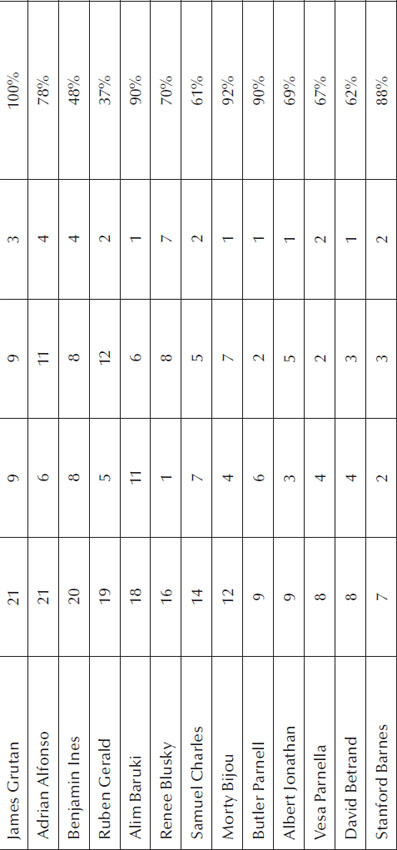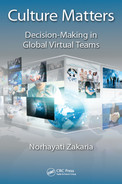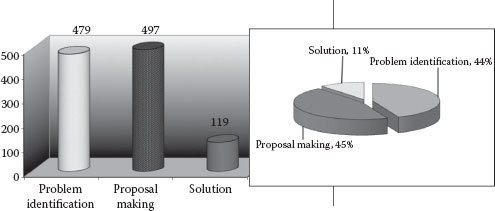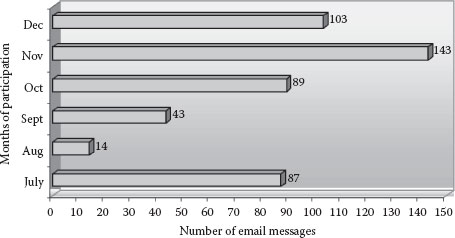Civil Society’s Contributions in the Decision-Making Processes
In this section, the following analysis looks at the proportion of messages in each of the three distinct stages of the decision-making processes (see Figure 8.1) and Civil Society global virtual team (GVT) members’ contributions in the process. In the “Problem Identification Process” section, I will describe the way Civil Society engaged in the problem identification processes and how high-context members differ from low-context members in the manner that they identify and understand problems, as well as the techniques that they apply when dealing with problems that were encountered during their discussions.
Problem identification (n = 479) accounted for 44%, proposal making (n = 497) accounted for 45%, and solution (n = 119) accounted for only 11% of all total decision-making activities. Together, problem identification and proposal-making activities made up 89% of the activities. This high proportion strongly suggests that Civil Society participants were committed in identifying issues that arose specifically within their collaboration, as well as sharing their proposals, ideas, and suggestions arising from their expertise in order to influence the language of the two key documents (Declaration of Principles and Plan of Action), which were the outcome of WSIS Geneva.
Figure 8.1 Distribution and proportion of the decision-making activities in WSIS Geneva.
In addition, the findings showed a total of 1,095 messages related to decision-making activities, or 62% of the total messages (N = 1,760) in the six-month period. Out of the 57 participants identified as active Civil Society participants (see Table 8.3), almost all of them (96%, n = 55) contributed to the decision-making activities. Specifically, contributions made by active participants accounted for 83% (n = 908) of the decision-making messages, while many fewer contributions were made by less active participants, representing a mere 17% (n = 187) of the messages.
Further analysis of decision-making messages indicated that not all the messages posted by the active participants were related to the decision-making process. As illustrated in Table 8.1, active participants contributed a total of 1,351 messages to the listserv. About 67% of their messages were related to decision, while only a small portion (33%) was contributed to the nonrelated decision-making activities. The following result showed the breakdown of two categories of participants that contributed to two categories of activities—(1) decision- and (2) non-decision-related activities based on the number of emails contributed. The result showed that, in general, active participants contributed far many more than less active participants. By looking at the total number of emails each group contributed, it is also apparent that active participants generated far more decision-making and non-decision-making messages than the less active participants, a difference of almost 70%.
Table 8.1 Distribution of Messages for Decision and Non-Decision-Making Activities between Active and Less Active Participants
Participants/Activities | Active Participants | Less Active Participants | Total |
Decision-making | 908 mails | 187 mails | 1,095 mails |
Non-decision-making | 443 mails | 222 mails | 665 mails |
Total | 1,351 mails | 409 mails | 1,760 mails |
The subsequent findings further detailed the degree of effectiveness of active participants based on several analyses. The analysis was made based on 55 active participants (see Table 8.2). Two of the active participants did not contribute to the decision-making process. About 58% of the active participants (n = 35) participated in all three stages of the decision-making process. And two participants, Wutz Kaiser and James Grutan, contributed 100% of their messages to the three stages of the decision-making process. In terms of the ranking based on the number of messages devoted to decision making, Kathryn Betty was still ranked as the highest contributor to the process, and she participated in all the activities, especially in the solution stage.
Not all participants (n = 20) contributed their efforts in all three stages. Participants who engaged in only two stages are shown in Table 8.3. Note that even though these participants did not engage in all three phases of the decision-making process, particularly solution stage, the majority of them contributed actively to the first two stages. In fact, for three of the the participants—(1) Steven, (2) Yihong, and (3) Rolan—100% of their messages concerned some phase of decision making, either actively addressing problems or making proposals, as well as responding to them.
Table 8.2 Ranking and Distribution of Active Participants for All Decision-Making Stages



Table 8.3 Ranking and Distribution of Participants Who Participated in Two Decision-Making Stages


Problem Identification Process
According to Adler (1997), the process of decision making begins with problem recognition, which I refer to as problem identification. The findings showed that there were two types of situations that took place during this early stage of decision making: (1) Civil Society participants discussed their problems and concerns, and (2) Civil Society participants discussed an agenda that was clearly identified—for example, based on a list of problems or topics to be addressed. After a problem was brought up by a member, other participants began to respond to it by either providing their ideas and opinions or making suggestions. Some responses were simply feedback or comments about the problem identified, but some were more concrete suggestions on how to solve the problems. It is important to note that at this stage, Civil Society participants only responded to the problems that were identified by others. If a problem was not clearly raised or mentioned in the email, then the issue could not be discussed. Thus, this initial stage is critical because unless and until people identify the problems, a solution could not be achieved. The findings also showed that agenda-driven discussions seemed to make the decision-making process within and among the Civil Society participants go in a more directed manner and got discussed more often.
As Figure 8.2 shows, problem identification instances were highest in November (n = 143) and December (n = 103). This pattern is consistent with the overall pattern of Civil Society participation in WSIS Geneva. Overall, the central topic of discussion throughout the six months was the language of the two primary documents—Declaration of Principles and Plan of Action. However, there was also a distinct agenda in some of the months. For example, in July (n = 87), participants were concerned about the setup of the infrastructure such as the availability of computers, Internet, and wireless connections; working space and room; and the structure and mechanism of the Civil Society. In November, participants were more concerned about the nomination of the speakers, as well as the time slot, and, in December, they focused on finalizing the language of the document, as well as selecting their speaker, in order to be fully prepared for the summit that took place in mid-December 2003.
Figure 8.2 Problem identification activities in WSIS Geneva.
The problems that Civil Society participants identified in WSIS Geneva include the following:
■ Infrastructure—technology issues on connectivity, wireless, and logistics such as meeting room and working space
■ Language—the problem of using English in email, translations, and the use of other non-English language such as using Spanish, French, or any other United Nations (UN) languages
■ Structure—the mechanism, organization, and coordination for civil society
■ Resources—giving out badges or limited passes for entrance to PrepComs’ meetings and the WSIS
■ Coordination—problems in coordinating the efforts within civil society in terms of sending the comments of the document, and deadlines to submit comments
■ Procedures—formatting issues on sending drafts, where and how to send documents
Table 8.4 provides more detailed examples of problem identification statements based on the WSIS emails.
Additionally, Civil Society participants were engaged in the agenda-driven discussions in respect of (1) the language of the two drafted documents and (2) the nomination of speakers—a participant who is chosen by consensus to represent Civil Society participants in the summit. The main goal was to influence these two documents. The findings indicated that a member in a leadership role often took up the task of agenda setting, and this role is based on his or her own initiative. The leader would set a certain agenda and request attention and/or action from the Civil Society participants. For example, Benjamin clearly set an agenda by asking for comments for a draft document as follows:
All*
Attached is the latest draft of the Civil Society priorities document for Paris. Please send comments by Friday to @wsis-cs.org.
We must produce the final document by the weekend.
BI
Table 8.4 Examples of Problem Identification Statements
Types of Problems | Quotations from Email Messages |
a. Infrastructure | • “Many thanks for this. Will there be computers in the drafting room? And will there be any Internet access other than the Internet cafe (which presumably will be much in demand)?” • “Can Civil Society representatives who are also accredited under a govt. delegation enter the room? If so, might they be able to relay us the news using Wireless?” |
b. Language | • “Saras and Anita echo your concerns and also raise the issue of Portuguese-speaking participants?” • “The Content & Themes group needs help to produce translations prior to the meeting. CT has one member working on the French version, but could use assistance. We have not yet identified people for other languages.” |
c. Structure and Mechanism of CS | • “I am sorry but I do not see why we need to discuss the structure of CS again, coming back to issues that have previously already been clarified. I do fully agree with you that transparency is very important, but I believe the current system, where the CS Contents and Themes Group, as well as the CS Bureau report back to the CS Plenary works just fine.” • “Certainly, issues such as Jeffrey Gerber’s comments on the Plenary, if he is to chair the Bureau, need clarification and agreement—they cannot be ignored. And this is a non-contentious way of doing that which all sides the integrity of their views.” |
d. Resources | • “I’ve followed the exchanges regarding the issue of passes for the summit. They express the latest scandal regarding the process.” • “What are these photo badges? Does that mean that they will take a photo during registration or is that a new kind of badge that we should ask for? Also, should all the accredited organization contact ict4d? What for, another kind of badge?” |
e. Coordination | • “We discussed the need to work immediately on coordination and logistics plan for PrepCom III. Lisa Larry has asked that we submit at least a rough outline of our logistical needs this week. Rolf Bauer has drafted a document outlining these needs, based on discussions at the end of PrepCom II and as a result of our experiences during the Intersessional.” • “This is good strategic document that I think gets us closer to the kind of coordinated functioning that Civil Society should aim towards. However, in terms of what is possible to get together between now and September, I think your overall scheme is ambitious. Let me suggest something perhaps more achievable.” |
f. Procedures | • “I think there should be joint discussions on this and other questions of common concern, so I am circulating to these lists (there are no contentious personal views, I hope). It concerns guidelines for the allocation of speaker slots at the PrepComs etc.” • “We have put the CS priorities document online at http://www.worldsummit2003.de/download_en/WSIS-CS-CT-Paris-071203.rtf. We also have produced an overview with all practical infos on the Paris meeting, including a timetable with the (so far) announced CS activities. I will be in Paris from tomorrow evening and report for our web site on a daily basis. Check http://www.worldsummit2003.org for more updates and news in the next days.” |
The data also showed that in certain situations, people responded to the agenda at different times. Some agenda generated many responses, whereas others did not even get a response; this seemed to depend on the nature of the agenda and whether it caught the participants’ attention. For the three months that generated the highest number of instances, the participants responded more vigorously because there was a deadline in the agenda (for example, language for the drafted documents or problems regarding the infrastructure).
Adler (1997) suggests that once people recognize a problem, the next stage is information search, a question of how people find and gather information to solve the problem. In WSIS Geneva, this stage was obvious during the iterative response to and deliberation on the problem or agenda, so, in this study, the information search stage is actually embedded in the response and deliberation stage. Therefore, I did not explicitly differentiate the information search stage in the empirical model.
Problem Identification Behaviors
The key question here is to understand the manner in which people express the concerns, issues, or problems that they faced in the WSIS Geneva. High-context participants presented their problems without using the word problem explicitly in their email. Neither did they use words like concerns or issues. Instead, they used ambiguous phrases like “I am afraid that…” or “perhaps it would be…” Another approach was either using polite gestures in the message like “thank you for the great work…” or apologizing, such as “I am sorry for not describing the whole scene…” Only then would they be comfortable in presenting the problems.
Even then, they still stated the essence of their concerns indirectly. For example, high-context participants usually provided lengthy messages about a problem. Sometimes, the problems or concerns were so deeply buried in the anecdotal stories that the substance of the problem was lost. Because the problem was blurred and not concisely stated, it was not taken seriously by the participants. For example, in Yihong Chang’s email, although his initial tone was direct, the words “I attach the outcome…” camouflage his real intention, which was to voice his concerns. Before expressing that concern, he offered an apology (“I am sorry”) and then proceeded with his concerns followed by a series of questions before he asserted his views. The following is a short excerpt of Yihong’s email from a longer version:
Here, I attach the outcome of the ad-hoc working group of Internet Governance.
Bracket part has not yet reached to an agreement.
I was told that the key conflicting part was number 4. (a) was proposed by the U.S. (b) was proposed by Brazil and China. And some countries made comments to delete the phrase of “under the UN framework,” so the remaining phrase is (c). Canada proposed (e) and EU and some other countries amended that proposal by deleting the phrase of “mutually agreed.”
I am sorry. This explanation was not given by official briefing.
Still, I have not heard any notification from that working group.
I should have tried to collect information what has been done behind the curtain. In this case, Internet or some ICTs are not helpful at all.
Could you solve this puzzle? What could be final consensus? In my view, the final consensus, if it could be, would be reached to coming December Summit. Quite frankly, I could not guess the possible compromise of these conflicting views. Anyhow, I am thinking the riddle of power balance and reason/understanding. My internal question is if we are going towards information and communication society or is it really progress of human beings?
Yihong Chang
In essence, high-context participants were not comfortable expressing their concerns forthrightly, which made their emails longer than those of low-context participants. The participants had to read such email closely in order to understand the main concerns. Sometimes, a message contained many concerns, and, as a consequence, the messages failed to address the main, urgent problems that required actions or solutions.
This is a different strategy from that used by low-context participants, who are more likely to jump into the matter immediately with a short question. Low-context people usually expressed their concerns straight to the point and used succinct wording. They sent messages with questions that pertained only to the concerns that they had or the problems that they encountered. Hence, low-context participants generally sent short messages like “Is there any wireless connection?” or “Will it be possible to connect our computers there?” Sometimes, the message included an explicit request regarding issues that concerned the plenary listserv participants such as the following from Denise Merraga:
I think that this issue is raging on and on. I know that people need to have the opportunity to choose and express opinions. I think that there also comes a time when the additions have to stop and we have to look at the list we have and choose.
Please let’s get to that point soon.
Denise
The brevity, relevance, and preciseness of such a communication style did capture the attention of other participants, as evidenced by the fact that the message received responses and solutions. For example, in regard to the wireless problem, Kathryn and Renee immediately took actions and solved the problem. Another example is that of Emilio, “Hello there, I cannot access the link you had provided…” Kathryn jumped straight away into the discussion and offered help on what to do. This is a classic example of a low-context person’s taskoriented way to solve the problem.
There were variations in the manner in which low-context people responded to a problem that arose or a concern that was expressed by the participants. For example, one member raised her concerns about the process and deadlines for registration. Benjamin responded,
I think the deadline was only for the fellowships.
I do not think that the travel information is necessary to complete the registration. I am a focal point and have successfully registered someone without that information. It may also be possible to go back and update the information. I am not sure though.
And Michael answered,
My reading of the WSIS website instructions is that while the organizations registering persons must have met the now-past deadline for accreditation, accredited organizations can even register persons at the desk on opening day. There are instructions there for both pre-registration and on-site registration.
Although the low-context people were precise in the manner that they posted problems or expressed their concerns, some of the responses were so terse as to seem hostile and blunt. For example, Samuel further responded in a harsh manner to Michael and Benjamin with an opening statement, such as
Not my understanding. December 3rd is the final date for accredited organizations to add people to their list of delegates.
Another succinct proposal arose when Civil Society participants discussed the issue of creating the North American/European caucus. Some participants voiced their disagreement, and some seemed to be in favor of it. However, when Ruben’s message (as follows) was sent, it almost sounded like a solution, although it was a proposal made in response to the issue. His message was crystal clear and sharp so that it is much easier to notice the priority and urgency of the message. The tone of the message sounded more like a command, yet there is also a hint of persuasion when he used the words “I would suggest…” He also used a semicolon after addressing Amanda, like “Amanda” is the topic or subject matter rather than referring to Amanda as a person:
Amanda:
there already is a north-america/european cacus group and mailing list for it. though it was late in forming, it was involved in many activities at pc3.
I would suggest joining that group.
Ruben
Not only were low-context participants precise in their email, but they also did not waste a lot of time communicating what they intended to get across to others. Their responses to problems can be simply providing people with the URL link when they requested information or quoted a specific text from other messages in order to reiterate a point or to clarify an issue that was brought up. For example, many of James Grutan’s responses to problems were as terse as this sentence, “The Secretariat just sent the tentative agenda. See below,” followed by the messages that he pasted into the text. Even though his email may be long, actually, the rest of the message was a pasted one.
Most of the high- and low-context people demonstrated consistent behavior throughout the six months. But some of them switched. Fredrick typically portrayed high-context behaviors, with an indirect manner of presenting his ideas and expressing his opinions. But, occasionally, his style reversed when he became more frustrated with the process. For, example, the following messages showed a more assertive style when he responded to Jenny’s and Mariette’s proposal:
Dear Jenny & Mariette,
about what ? about what kind of message ? if the CS speaker just speaks about generalities that are our least common divisor, officials in the UN assembly would certainly welcome it and felt relieved. Is this what the CS really wants ?
This is going to disappoint many persons in the whole world and specifically in emergent countries.
It is not required that the speaker be part of the “system,” be a former minister or some VIP, what is important is the content of the message and from that it should be determined what is the best speaker to deliver it and NOT the reverse way around.
and doesn’t put them off. for sure; some people will be upset, so what ? it simply means that something important is dealt with.
I am not sure RS is the best choice for this task.
You are perfectly right, but it is the proposed task which is not right in my views.
I personally suggest that this ridiculously small amount of time: five minutes (the only ones that would get world media coverage) must be put into some good practical use, it may be by RS with software patents, it may be by Mariette calling for the liberation of some imprisoned web masters, it may be another issue, but I suggest that we should agree to propose Opening speaker nominations based on the requirement of a practical impact.
Best regards
Fedrick
The impact of culture on problem identification activities can be summarized as follows:
■ If the problems were simple, easily fixed, and require less demanding actions, the low-context messages with short questions or concise statements generated more responses from other participants than the ambiguous or indirect problem statement that is given by high-context messages.
■ If the problems were complicated and needed more ideas and/or consensus, high-context messages can be equally valuable and useful as low-context detailed messages because both types of behaviors would present persuasive and strong logical arguments.
Adler, N.J. 1997. International Dimensions of Organizational Behavior, 3rd ed. Cincinnati, OH: South-Western.
* Please note that any typographical error or grammatical structures existed in the messages will not be corrected because the excerpts were taken directly from the data set. However, the only exception is that when messages include organizational names or any other important events in which all of that specific information will be removed or left blank in the messages as quoted in this study.


